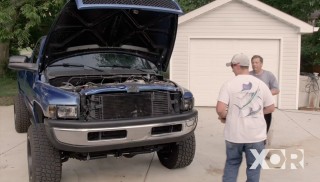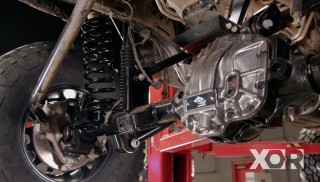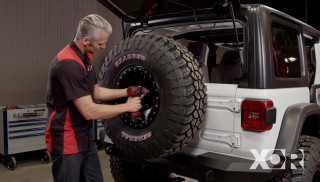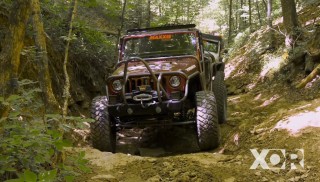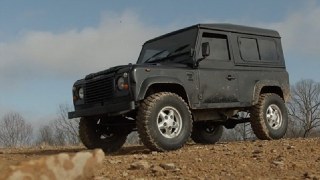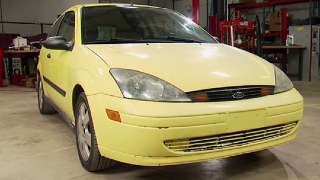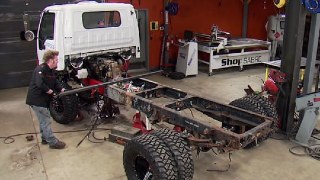XOR - Xtreme Off-Road Builds
Want more content like this?
Join the PowerNation Email NewsletterParts Used In This Episode
Lincoln Electric
Lincoln Electric is the official welding supplier to XOR
Matco Tools
Matco Tools are the official tool supplier of XOR
The Industrial Depot
Tools, Hardware, and Shop Supplies
Episode Transcript
(Narrator)>> Today Eliza and Jeremy are building a custom console, dash, and cowl in their pre-runner Ranger, and they're building a mount to carry both spares. Then they'll get their new digital gauges installed. It's all right here on XOR. ♪ ♪
(Eliza)>> Hey guys, welcome to XOR. Now that we've got most of our roll cage complete it is time to start working on the interior, and that begins with the center console and a shifter mount. ♪ ♪ The first piece is the lower bar that will serve as a mounting point for my console. It also connects from one B-pillar post to the other. [ welder crackling ] ♪ ♪
(Eliza)>> Alright, let's get the other bars in, fit those up. These are the structural tubes of the console itself. We're mocking up the driver's seat in place so we know how wide our console can be. ♪ ♪ These connect from my lower bar to the lower dash bar. Alright I need to cover up the seat so we don't ruin it. ♪ ♪ [ welder crackling ] ♪ ♪
(Eliza)>> The passenger side bar is placed about six inches from the first bar. [ welder crackling ] ♪ ♪
(Eliza)>> Get the seat out of here so we continue plugging away. ♪ ♪ Thanks you! With the seat out of the way now I can tack the console tubes to our lower cross bar. [ welder crackling ] ♪ ♪
(Eliza)>> This thick plate of steel will serve as the mount for our race shifter. [ welder crackling ] ♪ ♪
(Eliza)>> That's where, that's where that shifter goes. These small cross plates will serve as both reinforcement and mounting points for the thin gauge aluminum that will cover our console. [ welder crackling ] ♪ ♪
(Eliza)>> Thank you Jeremy! ♪ ♪ This is 20 gauge aluminum and it can be easily manipulated into the shape we want. ♪ ♪ [ drill spinning ]
(Eliza)>> Since I'm not ready to do the final install I'm using Clecos to hold this piece in place. Plus they save the soft aluminum from wear and tear when we take it back out to finish the interior before installing it one last time. Then it'll be permanently screwed in place. ♪ ♪ If you have never used Clecos they expand on the far side of the work piece and then draw and clamp them together while maintaining the desired alignment and preventing distortion of the pieces. They should fit snuggly in their holes to prevent shifting of the work piece as I shape the aluminum. Another benefit is that they can maintain the alignment of the drilled fastener holes that do not have Clecos in them. [ drill spinning ] ♪ ♪
(Eliza)>> Alright, done.
(Narrator)>> Up next we'll get our dash panel and cowl installed, and later we'll install our new digital dash.
(Eliza)>> Hey guys, welcome back to XOR. With most of our center console completed now it's time to start working on the dash, and that starts with a little bit of measuring and some cutting of angle iron. ♪ ♪ [ saw cutting metal ]
(Eliza)>> I need a vertical reference to measure the dash bracket that will push the bottom of our dash panel outward. These brackets are also cut out of angle iron. ♪ ♪ [ welder crackling ] ♪ ♪
(Eliza)>> This long piece serves as the bottom mounting point and support for our dash panel. [ welder crackling ] ♪ ♪
(Eliza)>> Fits pretty good on my side. Yours does too, cool! ♪ ♪ I'm using a level to make sure the two center dash mounting points are parallel with our panel. ♪ ♪ [ welder crackling ]
(Eliza)>> And the magnets built into the level help keep these two small mounting plates in place as they get tacked. ♪ ♪ [ welder crackling ]
(Eliza)>> And the same goes for the two outside mounts. ♪ ♪ [ welder crackling ]
(Eliza)>> Jeremy can you hand me the dash? Thank you. ♪ ♪ Woo, that's gonna work out great. ♪ ♪ I'm using a square to mark my drill holes on the panel. This keeps me in line with the angle iron mounting plates now behind the dash. ♪ ♪ [ drill spinning ] ♪ ♪
(Eliza)>> A small amount of tape wrapped around the drill bit helps protect the panel from scratches that would be left by the impact of the chuck jaws. ♪ ♪ I'm taking the same approach for mounting the cowl. Angle iron brackets for support. ♪ ♪ The cowl will serve to keep rocks and debris out of the cab and behind the dash. It'll also protect our racing gauge cluster that we are going to install. ♪ ♪ [ welder crackling ] ♪ ♪
(Eliza)>> The cowl is made from the same 20 gauge aluminum that our console cover is made of. ♪ ♪ [ drill spinning ]
(Eliza)>> And since we don't know just how many times this cowl will need to come off and go back on during the build, like the console we are going to temporarily secure it in place with Clecos. ♪ ♪ [ drill spinning ]
(Eliza)>> Since Clecos are a blind fastener they can be installed in places where you don't have access to the other side. [ drill spinning ] ♪ ♪ [ drill spinning ]
(Eliza)>> Woo hoo! If you're looking for a quality locker like we put in our Scout then Eaton's Detroit Locker is just the solution. This is Eaton's Detroit True Track differential locker. True Track is a helical gear type limited slip differential. This provides automatic division of torque. Under normal driving conditions True Track performs like an open differential. On wet, muddy, icy, or loose terrain the imbalance gear forces engage the locker and provide automatic traction to both your tires on your axle. So if you need to get the most torque and traction to your four wheels then check out Eaton's Detroit Locker.
(Narrator)>> When we come back we're building a spare tire carrier for both our spares.
(Eliza)>> Hey guys, welcome back. Over the break we decided to get our seats installed and the installation was fairly straight forward. We made some bracketry out of thick plate steel and tied it all in with some angle iron, and we picked up these five point harness seats from Summit Racing dot com.
(Jeremy)>> With the interior coming along nicely it's time to move to the back half of the truck because when we're out on the trails we're definitely gonna want to be carrying some spare tires. So we're gonna build a spare tire carrier cause we're not gonna only be hauling one. We're gonna be hauling dos.
(Eliza)>> Si!
(Jeremy)>> The first piece, hopefully the tires will sit against this and it's actually gonna tie the cage together in the back a little bit. We chose a unique way of attaching this tube to our roll cage. We just put it in the notcher and cut half way through it. ♪ ♪ Find the center of the chassis. About 27, half of that's about 13 and a half. So I'll mark it here. ♪ ♪ One there, and we'll put one there. Alright, after a quick trip to the bender this should hopefully be the piece that supports our tires above the fuel cell. [ welder crackling ] ♪ ♪
(Jeremy)>> Now we'll put a tire up, see how it sits. Alright, let's see if it stayed above the fuel cell. Perfect! Got about an inch or so. That'll work great. Hopefully this bar will keep the tires from falling out. [ welder crackling ] ♪ ♪
(Jeremy)>> Alright, now with both spare tires in here we know that they're not gonna roll out the back but we've got to find a way to keep them from falling in on each other. So we're gonna have to add a couple of pieces of bracing in between there. One in the front, hopefully tie this all together. Alright set this up, we'll try like four, six and a quarter. This bar will act as the front mount and will also provide extra strength in our cage. ♪ ♪ [ welder crackling ] ♪ ♪
(Jeremy)>> These bars will keep the tires from falling in on each other, and again will add more strength to the cage. [ welder crackling ] ♪ ♪
(Jeremy)>> About the same area. Nine inches to the center. Measure twice. ♪ ♪ [ welder crackling ] ♪ ♪
(Jeremy)>> That fits. Now we'll just add some braces that are gonna run up and down to support the whole back loop. Throughout our entire build we've been using the same material. This is inch and three quarter 120 wall d-o-m tubing. These bars will help support the entire carrier from high G-force landings when we fall out of the sky. [ welder crackling ]
(Jeremy)>> And on the other hand we're also gonna add some eyelets we made on our Edwards Ironworker. These will allow us to strap down the tires and keep them from flying away when we launch into the sky. ♪ ♪ And we picked up these Y-type spare tire hold downs from Summit Racing dot com. ♪ ♪ You're not going anywhere.
(Narrator)>> After the break we'll get our digital gauge mounted at just the right angle, stick around.
(Eliza)>> Hey guys welcome back to XOR. We're getting ready to do the final install of our aluminum dash, and that means getting the cluster fitted in. We have chosen to go with Race Pack's IQThree-S. It's able to program up to five drivers names, programmable shift and warning lights, four user defined alarms such as temperature, r-p-m, oil pressure, and has gear indicator. The dash comes with the software and programming cable, and we've picked up their accessory kit to run all options. The main reason why we have chosen the IQThree-S is because you can view vital functions easily and quickly, and it is also compatible with any of Race Pack's VNet data logging, which means you can view all vital signs and driver behavior all in the same log. And now that we have our seats in we have a good idea of where our steering wheel is gonna be, and I don't want to have the cluster in our line of sight. So that means we're gonna move it down some. I don't want to ever have to leave our field of vision. So I'm gonna go ahead and get this angled towards the driver. With the dash panel out of the pre-runner the first thing I need to do is cut a slot out for the wiring harness to connect to the back of our gauges. ♪ ♪ A small sanding disc will take care of the burrs and sharp edges of our cut. [ metal grinding ]
(Eliza)>> Okay! Oh that looks good. Now to cut this out here so that we can bend along this line, and we'll have it angled towards the driver. [ saw cutting metal ]
(Eliza)>> After smoothing the cuts, once again I'm simply prying up my cutout panel to about a 30 degree angle. ♪ ♪ I think that's a go! I've cut out aluminum triangles to close off the top and the bottom. [ welder crackling ]
(Eliza)>> Since this is aluminum I will be choosing to tig weld this together. The tig process gives me better heat control as well as has a cleaner look. ♪ ♪ For more information about anything you've seen on today's show visit us at Powernation TV dot com. ♪ ♪ Alright, there you have it. Dash in, gauges in, now let's move on to more importanter things, like racing. ♪ ♪
(Jeremy)>> For those of you guys that may be running bigger wheels and tires on your truck, well you're probably gonna run into an instance when you need to change those bigger wheels when you're out on the trail. Well we know that that stock jack that came with your truck isn't gonna cut it. So we're gonna show you a way to carry a bigger, more heavy duty jack and also show you a way to keep that jack from sinking in the mud or sinking in the sand. ♪ ♪ We're gonna start by putting down some measurements on a piece of 16 gauge sheet metal. The piece we're gonna use is about 23 inches by about 12 and a half inches. ♪ ♪ And then we'll mark a one inch bend line and head over to the break. ♪ ♪ That was bent just a little under cause you can always go more. ♪ ♪ And we're just gonna weld this to a section of our pre-runner's cage. [ welder crackling ]
(Jeremy)>> And now this is a great spot cause it's right next to our spare tires. Now all I have to do is come up with a way to keep this from sinking in the mud or the sand. And this is how we're gonna keep this from sinking into the sand. We're gonna weld on a piece of aluminum onto the bottom to disperse the weight, and we made this the same way we made the carrier. Now all I have to do is prep this for welding. An angle grinder and a grinding disc quickly take the powder coating off the jack. ♪ ♪ Now this is an aluminum race jack. So we're simply gonna tig weld the plate on. [ welder crackling ] ♪ ♪
(Jeremy)>> Now we welded in a couple pieces of tubing to hold the handles in place, and when you set the jack down that also keeps the handles from falling out. We also welded in some washers to help pull down the hold down.
Show Full Transcript
(Eliza)>> Hey guys, welcome to XOR. Now that we've got most of our roll cage complete it is time to start working on the interior, and that begins with the center console and a shifter mount. ♪ ♪ The first piece is the lower bar that will serve as a mounting point for my console. It also connects from one B-pillar post to the other. [ welder crackling ] ♪ ♪
(Eliza)>> Alright, let's get the other bars in, fit those up. These are the structural tubes of the console itself. We're mocking up the driver's seat in place so we know how wide our console can be. ♪ ♪ These connect from my lower bar to the lower dash bar. Alright I need to cover up the seat so we don't ruin it. ♪ ♪ [ welder crackling ] ♪ ♪
(Eliza)>> The passenger side bar is placed about six inches from the first bar. [ welder crackling ] ♪ ♪
(Eliza)>> Get the seat out of here so we continue plugging away. ♪ ♪ Thanks you! With the seat out of the way now I can tack the console tubes to our lower cross bar. [ welder crackling ] ♪ ♪
(Eliza)>> This thick plate of steel will serve as the mount for our race shifter. [ welder crackling ] ♪ ♪
(Eliza)>> That's where, that's where that shifter goes. These small cross plates will serve as both reinforcement and mounting points for the thin gauge aluminum that will cover our console. [ welder crackling ] ♪ ♪
(Eliza)>> Thank you Jeremy! ♪ ♪ This is 20 gauge aluminum and it can be easily manipulated into the shape we want. ♪ ♪ [ drill spinning ]
(Eliza)>> Since I'm not ready to do the final install I'm using Clecos to hold this piece in place. Plus they save the soft aluminum from wear and tear when we take it back out to finish the interior before installing it one last time. Then it'll be permanently screwed in place. ♪ ♪ If you have never used Clecos they expand on the far side of the work piece and then draw and clamp them together while maintaining the desired alignment and preventing distortion of the pieces. They should fit snuggly in their holes to prevent shifting of the work piece as I shape the aluminum. Another benefit is that they can maintain the alignment of the drilled fastener holes that do not have Clecos in them. [ drill spinning ] ♪ ♪
(Eliza)>> Alright, done.
(Narrator)>> Up next we'll get our dash panel and cowl installed, and later we'll install our new digital dash.
(Eliza)>> Hey guys, welcome back to XOR. With most of our center console completed now it's time to start working on the dash, and that starts with a little bit of measuring and some cutting of angle iron. ♪ ♪ [ saw cutting metal ]
(Eliza)>> I need a vertical reference to measure the dash bracket that will push the bottom of our dash panel outward. These brackets are also cut out of angle iron. ♪ ♪ [ welder crackling ] ♪ ♪
(Eliza)>> This long piece serves as the bottom mounting point and support for our dash panel. [ welder crackling ] ♪ ♪
(Eliza)>> Fits pretty good on my side. Yours does too, cool! ♪ ♪ I'm using a level to make sure the two center dash mounting points are parallel with our panel. ♪ ♪ [ welder crackling ]
(Eliza)>> And the magnets built into the level help keep these two small mounting plates in place as they get tacked. ♪ ♪ [ welder crackling ]
(Eliza)>> And the same goes for the two outside mounts. ♪ ♪ [ welder crackling ]
(Eliza)>> Jeremy can you hand me the dash? Thank you. ♪ ♪ Woo, that's gonna work out great. ♪ ♪ I'm using a square to mark my drill holes on the panel. This keeps me in line with the angle iron mounting plates now behind the dash. ♪ ♪ [ drill spinning ] ♪ ♪
(Eliza)>> A small amount of tape wrapped around the drill bit helps protect the panel from scratches that would be left by the impact of the chuck jaws. ♪ ♪ I'm taking the same approach for mounting the cowl. Angle iron brackets for support. ♪ ♪ The cowl will serve to keep rocks and debris out of the cab and behind the dash. It'll also protect our racing gauge cluster that we are going to install. ♪ ♪ [ welder crackling ] ♪ ♪
(Eliza)>> The cowl is made from the same 20 gauge aluminum that our console cover is made of. ♪ ♪ [ drill spinning ]
(Eliza)>> And since we don't know just how many times this cowl will need to come off and go back on during the build, like the console we are going to temporarily secure it in place with Clecos. ♪ ♪ [ drill spinning ]
(Eliza)>> Since Clecos are a blind fastener they can be installed in places where you don't have access to the other side. [ drill spinning ] ♪ ♪ [ drill spinning ]
(Eliza)>> Woo hoo! If you're looking for a quality locker like we put in our Scout then Eaton's Detroit Locker is just the solution. This is Eaton's Detroit True Track differential locker. True Track is a helical gear type limited slip differential. This provides automatic division of torque. Under normal driving conditions True Track performs like an open differential. On wet, muddy, icy, or loose terrain the imbalance gear forces engage the locker and provide automatic traction to both your tires on your axle. So if you need to get the most torque and traction to your four wheels then check out Eaton's Detroit Locker.
(Narrator)>> When we come back we're building a spare tire carrier for both our spares.
(Eliza)>> Hey guys, welcome back. Over the break we decided to get our seats installed and the installation was fairly straight forward. We made some bracketry out of thick plate steel and tied it all in with some angle iron, and we picked up these five point harness seats from Summit Racing dot com.
(Jeremy)>> With the interior coming along nicely it's time to move to the back half of the truck because when we're out on the trails we're definitely gonna want to be carrying some spare tires. So we're gonna build a spare tire carrier cause we're not gonna only be hauling one. We're gonna be hauling dos.
(Eliza)>> Si!
(Jeremy)>> The first piece, hopefully the tires will sit against this and it's actually gonna tie the cage together in the back a little bit. We chose a unique way of attaching this tube to our roll cage. We just put it in the notcher and cut half way through it. ♪ ♪ Find the center of the chassis. About 27, half of that's about 13 and a half. So I'll mark it here. ♪ ♪ One there, and we'll put one there. Alright, after a quick trip to the bender this should hopefully be the piece that supports our tires above the fuel cell. [ welder crackling ] ♪ ♪
(Jeremy)>> Now we'll put a tire up, see how it sits. Alright, let's see if it stayed above the fuel cell. Perfect! Got about an inch or so. That'll work great. Hopefully this bar will keep the tires from falling out. [ welder crackling ] ♪ ♪
(Jeremy)>> Alright, now with both spare tires in here we know that they're not gonna roll out the back but we've got to find a way to keep them from falling in on each other. So we're gonna have to add a couple of pieces of bracing in between there. One in the front, hopefully tie this all together. Alright set this up, we'll try like four, six and a quarter. This bar will act as the front mount and will also provide extra strength in our cage. ♪ ♪ [ welder crackling ] ♪ ♪
(Jeremy)>> These bars will keep the tires from falling in on each other, and again will add more strength to the cage. [ welder crackling ] ♪ ♪
(Jeremy)>> About the same area. Nine inches to the center. Measure twice. ♪ ♪ [ welder crackling ] ♪ ♪
(Jeremy)>> That fits. Now we'll just add some braces that are gonna run up and down to support the whole back loop. Throughout our entire build we've been using the same material. This is inch and three quarter 120 wall d-o-m tubing. These bars will help support the entire carrier from high G-force landings when we fall out of the sky. [ welder crackling ]
(Jeremy)>> And on the other hand we're also gonna add some eyelets we made on our Edwards Ironworker. These will allow us to strap down the tires and keep them from flying away when we launch into the sky. ♪ ♪ And we picked up these Y-type spare tire hold downs from Summit Racing dot com. ♪ ♪ You're not going anywhere.
(Narrator)>> After the break we'll get our digital gauge mounted at just the right angle, stick around.
(Eliza)>> Hey guys welcome back to XOR. We're getting ready to do the final install of our aluminum dash, and that means getting the cluster fitted in. We have chosen to go with Race Pack's IQThree-S. It's able to program up to five drivers names, programmable shift and warning lights, four user defined alarms such as temperature, r-p-m, oil pressure, and has gear indicator. The dash comes with the software and programming cable, and we've picked up their accessory kit to run all options. The main reason why we have chosen the IQThree-S is because you can view vital functions easily and quickly, and it is also compatible with any of Race Pack's VNet data logging, which means you can view all vital signs and driver behavior all in the same log. And now that we have our seats in we have a good idea of where our steering wheel is gonna be, and I don't want to have the cluster in our line of sight. So that means we're gonna move it down some. I don't want to ever have to leave our field of vision. So I'm gonna go ahead and get this angled towards the driver. With the dash panel out of the pre-runner the first thing I need to do is cut a slot out for the wiring harness to connect to the back of our gauges. ♪ ♪ A small sanding disc will take care of the burrs and sharp edges of our cut. [ metal grinding ]
(Eliza)>> Okay! Oh that looks good. Now to cut this out here so that we can bend along this line, and we'll have it angled towards the driver. [ saw cutting metal ]
(Eliza)>> After smoothing the cuts, once again I'm simply prying up my cutout panel to about a 30 degree angle. ♪ ♪ I think that's a go! I've cut out aluminum triangles to close off the top and the bottom. [ welder crackling ]
(Eliza)>> Since this is aluminum I will be choosing to tig weld this together. The tig process gives me better heat control as well as has a cleaner look. ♪ ♪ For more information about anything you've seen on today's show visit us at Powernation TV dot com. ♪ ♪ Alright, there you have it. Dash in, gauges in, now let's move on to more importanter things, like racing. ♪ ♪
(Jeremy)>> For those of you guys that may be running bigger wheels and tires on your truck, well you're probably gonna run into an instance when you need to change those bigger wheels when you're out on the trail. Well we know that that stock jack that came with your truck isn't gonna cut it. So we're gonna show you a way to carry a bigger, more heavy duty jack and also show you a way to keep that jack from sinking in the mud or sinking in the sand. ♪ ♪ We're gonna start by putting down some measurements on a piece of 16 gauge sheet metal. The piece we're gonna use is about 23 inches by about 12 and a half inches. ♪ ♪ And then we'll mark a one inch bend line and head over to the break. ♪ ♪ That was bent just a little under cause you can always go more. ♪ ♪ And we're just gonna weld this to a section of our pre-runner's cage. [ welder crackling ]
(Jeremy)>> And now this is a great spot cause it's right next to our spare tires. Now all I have to do is come up with a way to keep this from sinking in the mud or the sand. And this is how we're gonna keep this from sinking into the sand. We're gonna weld on a piece of aluminum onto the bottom to disperse the weight, and we made this the same way we made the carrier. Now all I have to do is prep this for welding. An angle grinder and a grinding disc quickly take the powder coating off the jack. ♪ ♪ Now this is an aluminum race jack. So we're simply gonna tig weld the plate on. [ welder crackling ] ♪ ♪
(Jeremy)>> Now we welded in a couple pieces of tubing to hold the handles in place, and when you set the jack down that also keeps the handles from falling out. We also welded in some washers to help pull down the hold down.


